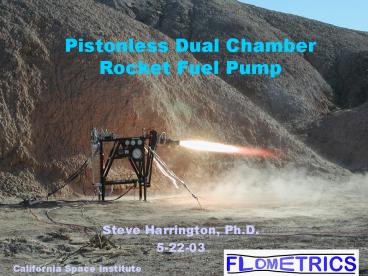Pistonless Dual Chamber Rocket Fuel Pump - PowerPoint PPT Presentation
1 / 18
Title:
Pistonless Dual Chamber Rocket Fuel Pump
Description:
For performance, a rocket must have large, lightweight propellant tanks ... NASA. Fastrac. TRW. Low Cost Pintle Engine. Beal. BA 810. Microcosm. Scorpius ... – PowerPoint PPT presentation
Number of Views:3596
Avg rating:3.0/5.0
Title: Pistonless Dual Chamber Rocket Fuel Pump
1
Pistonless Dual Chamber Rocket Fuel Pump
- Steve Harrington, Ph.D.
- 5-22-03
California Space Institute
2
LOX/Jet-A Pressure Fed Design Working Well
Whats Next? More Altitude!
3
The Problem is Mass Ratio How to Make a
Lightweight, Inexpensive Rocket with a Large Fuel
Capacity.
- For performance, a rocket must have large,
lightweight propellant tanks - Pressure fed tanks are heavy and/or expensive and
safety margins cost too much in terms of
performance. - Turbopumps require massive engineering effort and
are expensive. - The solution is the The Dual Pistonless Pump
- Simple to design and manufacture and with
performance comparable to a turbopump and
complexity comparable to a pressure fed system.
4
Outline
- Discuss basic pump design concept
- Introduce latest pump innovations
- List pump advantages over turbopump and pressure
fed systems. - Present pump test results
- Derive calculation of pump thrust to weight ratio
which show that a LOX/RP-1 pump has a T/W of over
700
5
First Generation Design
- Drain the main tank at low pressure into a small
chamber. - Pressurize the small chamber and feed to the
engine. - Run two in parallel, venting and filling one
faster than the other is emptied
More info at www. rocketfuelpump.com
6
Second Generation Design
- Main chamber vents and fills quickly through
multiple check valves. - One main chamber and one auxiliary chamber,
less weight than two chambers of equal size - Pump fits in tank, simplified plumbing
- Concentric design maintains balance.
- Model has been built and tested (patent pending)
7
Advantages
- Much lighter than pressure fed system at similar
cost. - At one to two orders of magnitude lower
engineering and manufacturing cost than
turbopump. - Low weight, comparable to turbopump.
- Quick startup, shutdown. No fuel used during
spool up. - Can be run dry. No minimum fuel requirement.
- Less than 10 moving parts. Inherent reliability.
- Inexpensive materials and processes.
- Negligible chance of catastrophic failure.
- Scalable, allows for redundant systems.
8
Engineering Cost Dual Pistonless Pump
- Check Valves
- Level Sensors
- Pressure vessels
- These parts are available off the shelf
- Control System (microprocessor or logic circuit)
Pump model made from industrial/consumer parts 4
MPa, 1.2 kg/sec, 7 kg
9
Engineering cost Turbopumps
- Fluid Dynamics of rotor/stator
- Bearings
- Seals
- Cavitation
- Heat transfer
- Thermal shock
- Rotor dynamics
- Startup
- Shut down
10
Development Issues
- Currently uses slightly more gas than pressure
fed system. Can use less with pressurant heating. - Not invented here.
- No experience base, must be static tested and
flown. - Requires different system optimization than
pressure fed or turbopump systems no sample
problems in the book.
11
Pump Performance
- Pump performance close to target of 1.5 kg/sec at
4 Mpa - Pressure spikes have been reduced.
- Pump chamber vents and pressurizes more quickly
when running on Helium - Pump needs to be tested with engine and flown to
prove design.
Pump running on compressed air at room
temperature, pumping water.
12
Pistonless Pump Mass Calculation
Chamber Mass
Spherical Chamber Volume and Diameter
Combine Equations to get Chamber Mass as a
function of flow rate
Chamber Thickness in terms of fuel pressure and
maximum stress
13
Pistonless Pump Thrust to weight Ratio
Calculation
- Assumptions
- Auxiliary chamber is 1/4 the size of main chamber
- Valves and ullage add 25 to mass
- Total pump mass is 1.252 or1.56 times main
chamber mass 1/(1.561.5).43
Thrust for Ideal Expansion
Pump thrust to weight
14
Typical Pump Thrust/Weight Calculations
Assumptions
- Rocket Chamber Pressure 4 MPa
- Pump cycle time 5 seconds.
- Sea level Specific Impulse from Huang and Huzel ,
- Pump Chambers are 2219 aluminum, 350 MPa design
yield strength, 2.8 specific gravity
15
Another Calculation Mass Savings of Pump and
Tank Over Pressure Fed Tank
- Mass of pressure fed tank is proportional to
volume and pressure - Mass of pump fed system is the mass of a lighter
low pressure tank plus the mass of the pump - Tank Mass Savings
- 200 KPa tank is 1/10 the weight of a 2 MPa tank.
- Pump chamber pressure is the same as pressure fed
tank pressure, but the volume is much less.
16
Pump Mass is Negligible for Long Burn Times
- The volume of the pump chamber is proportional
to the flow rate times the cycle time - The volume of the tank is equal to the flow rate
times the burn time. - Therefore the ratio of the pump chamber mass to
the tank mass is equal to the ratio of the cycle
time to the burn time if we put in a factor of
1.56 to account for the auxiliary chamber, valves
etc.
Pump volume ratio
Tank pressure ratio
17
Mass Savings over Pressure Fed System
5 second cycle time and 300 KPa tank pressure
18
Conclusions/ Future Plans
- Pump weight and cost are low and it works as
designed. - Next steps
- Static test and fly pump in student rocket with
Flometrics rocket technology. - Combine with low cost ablative engines and low
cost vehicles for low cost access to space.
NASA Fastrac
Beal BA 810
TRW Low Cost Pintle Engine
Microcosm Scorpius































